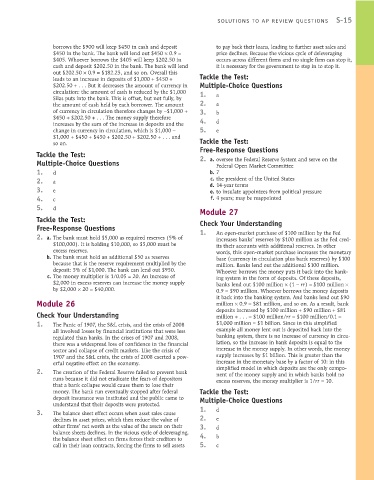Page 861 - Krugmans Economics for AP Text Book_Neat
P. 861
S-15
SOLUTIONS TO AP REVIEW QUESTIONS
borrows the $900 will keep $450 in cash and deposit to pay back their loans, leading to further asset sales and
$450 in the bank. The bank will lend out $450 × 0.9 = price declines. Because the vicious cycle of deleveraging
$405. Whoever borrows the $405 will keep $202.50 in occurs across different firms and no single firm can stop it,
cash and deposit $202.50 in the bank. The bank will lend it is necessary for the government to step in to stop it.
out $202.50 × 0.9 = $182.25, and so on. Overall this
leads to an increase in deposits of $1,000 + $450 + Tackle the Test:
$202.50 + . . . But it decreases the amount of currency in Multiple-Choice Questions
circulation: the amount of cash is reduced by the $1,000 1. a
Silas puts into the bank. This is offset, but not fully, by
the amount of cash held by each borrower. The amount 2. a
of currency in circulation therefore changes by −$1,000 + 3. b
$450 + $202.50 + . . . The money supply therefore 4.
increases by the sum of the increase in deposits and the d
change in currency in circulation, which is $1,000 − 5. e
$1,000 + $450 + $450 + $202.50 + $202.50 + . . . and
so on. Tackle the Test:
Free-Response Questions
Tackle the Test:
Multiple-Choice Questions 2. a. oversee the Federal Reserve System and serve on the
Federal Open Market Committee
1. d b. 7
2. a c. the president of the United States
3. e d. 14-year terms
e. to insulate appointees from political pressure
4. c f. 4 years; may be reappointed
5. d Module 27
Tackle the Test: Check Your Understanding
Free-Response Questions
1. An open-market purchase of $100 million by the Fed
2. a. The bank must hold $5,000 as required reserves (5% of increases banks’ reserves by $100 million as the Fed cred-
$100,000). It is holding $10,000, so $5,000 must be its their accounts with additional reserves. In other
excess reserves. words, this open-market purchase increases the monetary
b. The bank must hold an additional $50 as reserves base (currency in circulation plus bank reserves) by $100
because that is the reserve requirement multiplied by the million. Banks lend out the additional $100 million.
deposit: 5% of $1,000. The bank can lend out $950. Whoever borrows the money puts it back into the bank-
c. The money multiplier is 1/0.05 = 20. An increase of ing system in the form of deposits. Of these deposits,
$2,000 in excess reserves can increase the money supply banks lend out $100 million × (1 − rr) = $100 million ×
by $2,000 × 20 = $40,000. 0.9 = $90 million. Whoever borrows the money deposits
it back into the banking system. And banks lend out $90
Module 26 million × 0.9 = $81 million, and so on. As a result, bank
deposits increased by $100 million + $90 million + $81
Check Your Understanding million + . . . = $100 million/rr = $100 million/0.1 =
1. The Panic of 1907, the S&L crisis, and the crisis of 2008 $1,000 million = $1 billion. Since in this simplified
all involved losses by financial institutions that were less example all money lent out is deposited back into the
regulated than banks. In the crises of 1907 and 2008, banking system, there is no increase of currency in circu-
there was a widespread loss of confidence in the financial lation, so the increase in bank deposits is equal to the
sector and collapse of credit markets. Like the crisis of increase in the money supply. In other words, the money
1907 and the S&L crisis, the crisis of 2008 exerted a pow- supply increases by $1 billion. This is greater than the
erful negative effect on the economy. increase in the monetary base by a factor of 10: in this
2. The creation of the Federal Reserve failed to prevent bank simplified model in which deposits are the only compo-
nent of the money supply and in which banks hold no
runs because it did not eradicate the fears of depositors excess reserves, the money multiplier is 1/rr = 10.
that a bank collapse would cause them to lose their
money. The bank run eventually stopped after federal Tackle the Test:
deposit insurance was instituted and the public came to Multiple-Choice Questions
understand that their deposits were protected.
3. The balance sheet effect occurs when asset sales cause 1. d
declines in asset prices, which then reduce the value of 2. e
other firms’ net worth as the value of the assets on their 3. d
balance sheets declines. In the vicious cycle of deleveraging, 4.
the balance sheet effect on firms forces their creditors to b
call in their loan contracts, forcing the firms to sell assets 5. c

